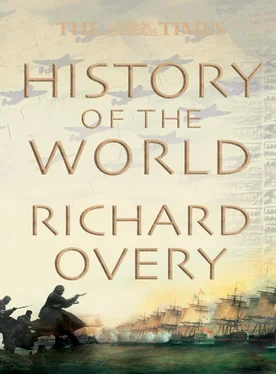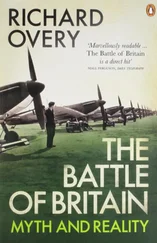Soon after 1200 BC, more or less simultaneously, the palaces on the mainland were destroyed. In the centuries following there is no trace of Linear B writing, nor of the figurative decoration that characterizes Mycenaean art. When written Greek appears again in the 8th century, it uses a version of the Phoenician alphabet.
The absence of firm evidence—mirrored by the lack of firm dates for this period—has led historians to examine myths in the search for historical facts. On this basis it has been suggested that the Mycenaeans fell victim to Dorian invaders from the north, or that a long war against Troy caused revolution in the Greek homeland. Neither finds support from archaeology, and an agreed explanation for the complete social breakdown of Mycenaean society is yet to emerge. One contributing factor may have been major political upheavals further east, cutting off access to the tin needed to make the bronze on which the Mycenaean rulers based their power. Certainly the society which emerged from the “dark age” that followed the collapse was reliant on the more widely available iron.
The massive ruins of the Mycenaean palaces remained visible to the Greeks of later times, and these, together with a tradition of oral poetry that developed over the following centuries, led to the invention of a heroic world, most famously celebrated in the epic poems of Homer, that was very different from Bronze Age reality.
THREE THE CLASSICAL CIVILIZATIONS OF EURASIA
The earliest civilizations arose at a few scattered points in the vast and sparsely inhabited Eurasian landmass. Between 1000 BC and AD 500 the pattern began to change. Although America, Australasia and Africa south of the Sahara still stood outside the mainstream of world history, and were to stay so for a further thousand years, the civilizations of Europe and Asia now formed a continuous belt. By AD 100, when the classical era was at its height, a chain of empires extended from Rome via Parthia and the Kushana empire to China, constituting an unbroken zone of civilized life from the Atlantic to the Pacific.
This was a new and important fact in the history of the Eurasian world. The area of civilization remained narrow and exposed to unrelenting barbarian pressures, and developments in the different regions remained largely autonomous. But with the expansion of the major civilizations and the elimination of the geographical gaps between them, the way lay open for inter-regional contacts and cultural exchanges which left a lasting imprint. In the west, the expansion of Hellenism created a single cultural area which extended from the frontiers of India to Britain; in the east, the expansion of the Chinese and Indian civilizations resulted in a kind of cultural symbiosis in Indo-China. These wider cultural areas provided a vehicle not only for trade but for the transmission of ideas, technology and institutions, and above all for the diffusion of the great world religions. Beginning with Buddhism, and continuing with Judaism, Zoroastrianism, Christianity and Islam, religion became a powerful unifying bond in the Eurasian world.
550 BC TO AD 752
THE COMMERCIAL AND CULTURAL BONDS OF EURASIA
The rulers of the empires of the ancient world had no commercial policies, and were seldom interested in trade. Yet the activities of traders, operating at the margins of society, and rarely mentioned in ancient literature, had a profound effect on the development of the world, transmitting not only goods, but also cultural ideas—and occasionally deadly organisms.
The quantity of goods passing across the Eurasian landmass varied enormously depending on the political conditions of the time. Between 200 BC and AD 200 stable regimes in the Roman Mediterranean, the Persian Parthian empire, the Kushan empire and China under the Han dynasty, helped to stabilize the routes between Europe, Persia and China. Such favourable conditions for the movement of goods and people did not recur until the 8th century AD. These earlier empires, however, were not directly interested in facilitating trade. Chinese campaigns in the area of the Silk Road in Sinkiang, north of Tibet, such as that of Pan Ch’ao against the Kushans in c. AD 90, confronted a military rather than a commercial threat. The Han emperors certainly wanted valuable commodities like horses from Ferghana, but they expected to receive them as diplomatic gifts, tribute or booty from war.
Since the time of Assyrian merchants in Anatolia in the second millennium BC there are examples of communities of traders who settled in foreign territories to import goods from their homelands. In the 8th century BC Greek and Phoenician trading posts were established across the Mediterranean for the same purpose. These “trade diasporas” made possible effective communication between different cultural groups. The people who made up the diaspora communities were not wealthy merchants, but of much lower status. The “Roman” traders who sailed across the Indian Ocean or visited the Chinese court would not have been Italians, but inhabitants of the eastern provinces, who were probably not even Roman citizens.
Trade was not the only way in which goods travelled across this route. The Han rulers of China maintained peace on their northwest frontier by regular gifts of large quantities of silk and lacquerware to the Hsiungnu tribes outside the Great Wall. Some items would have been passed on in dowries or as gifts, and gradually made their way to the Mediterranean where silken clothing was sought by Roman senators, much to the distaste of more austere emperors.
While silk was the major import from China to the Mediterranean, a variety of goods found their way westwards. The Roman writer Pliny (AD 23–79) complains that the desire for eastern goods was draining the empire of its gold and silver, but this is not supported by the archaeological evidence. Glass was certainly sought after, but slaves were probably also a significant item of trade, and there are references in Chinese sources to “Syrian jugglers” reaching the Chinese court.
MARITIME TRADE
Maritime trade developed at the same time as the overland routes, making increased use of the monsoons for trade between southern Arabia and south India. Vital information about the goods traded between the Roman empire and the east comes from A Voyage around the Red Sea , an anonymous handbook for traders written in the 1st century AD, which describes the coastal routes from the Egyptian Red Sea ports of Myos Hormus and Berenice to east Africa and the Ganges delta. The author knows of China as a vast city, but east of India his geographical knowledge is hazy.
The exchange of goods might have profound cultural effects. Begram in Gandhara was the location of the summer palace of the Kushan emperors. A rich hoard from there dating from around AD 100 included lacquer from China and ivory from India, as well as bronzes, glassware and pottery from the Mediterranean. The Kushan interest in Mediterranean artefacts illustrated by the Begram hoard had a profound effect on local practices, acting as a catalyst for the development of Gandharan art which emerged in the 2nd century AD, in part modelled on Greco-Roman styles.
1000–539 BC
THE NEAR EAST
As the Near East recovered from the upheavals of the late Bronze Age, Assyria re-emerged as the great regional power. At its greatest extent Assyrian territory stretched from the Mediterranean to the Persian Gulf, and from southern Egypt to Lake Van. At the height of Assyrian power, internal conflict saw the Babylonians replace the Assyrians as the rulers of the empire, but less than a century later they, in their turn, were overthrown by the Persians.
Our knowledge of this period is drawn largely from Assyrian, and later Babylonian, documents, but some idea of how neighbouring states saw Assyria can be gained from the Hebrew Bible, which contains historical material from the 8th century BC onwards. Although its narrative was revised several times in later centuries, the Bible provides information about the kingdoms of Israel and Judah, which emerged in the area of Palestine in around 1000 BC, initially as a single kingdom with its centre at Jerusalem. Over the next 300 years Israel and Judah came increasingly into the Assyrian sphere of influence, with their kings adopting varying attitudes to the neighbouring superpower.
Читать дальше










